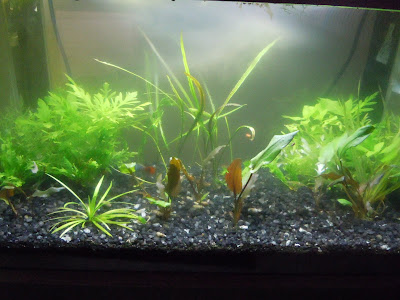The care and keeping of Triops
By: Wiktor
So years ago I got a little packet of triops eggs off the internet after stumbling on to information about these guys on a website. I followed the directions but after making a couple dumb mistakes they all died. I resolved that one day I’d try again to raise these interesting creatures. Some time later I came across another package at Hobby Lobby and then promptly put it on the shelf for several months. After reading an article in tropical fish hobbyist about Triops I set about the task of raising them and I got bit by the Triops bug. Despite the seemingly complicated process of raising them they are generally very easy to keep if you follow the rules.
Triops Australiensis, Note the grey area just above and between the eyes.
This is a third, simple eye! (hence the name Triops)
The Triops is a crustacean and despite looking like miniature horseshoe crabs they are most closely related to brine shrimp and daphnia belonging to the branchiopoda class. Branchiopoda meaning gill feet describes the breathing method of its members utilizing their many feathery legs to breath. Like brine shrimp Triops produce cysts which can remain viable in a state of suspended animation called diapause reportedly for as long as 30 years or more. Triops come from vernal pools which are only full of water for short periods before drying out much like annual killifish. Also like annual killifish they have a very rapid lifecycle going from newly hatched to dead in a couple months tops. Triops come from vernal pools which are only full of water for short periods before drying out much like annual killifish. Also like annual killifish they have a very rapid lifecycle going from newly hatched to dead in a couple months tops. An interesting fact is that the European Triops Cancriformis is the oldest still living creature on earth, pre-dating even the dinosaurs!
Triops eggs (hint they are the stuff that looks like sand)
Back to the story, my kit only managed to hatch one Triops (the retail packages are very stingy) and it grew before dying to nearly two inches! The process of rearing Triops begins with the dried eggs. Triops hatch when they come into to contact with water which is both free from dissolved organics and dissolved solids, distilled water works best for this purpose. It’s best to start them out in a small amount of water since they are essentially the size and appearance of baby brine shrimp upon hatching. Being so small means that they need to eat similarly tiny food sources and to this end kits all include some substance which contains infusorian cysts since this will be the only food source small enough for their tiny mouths until the Triops reach a few millimeters long. It is best at hatching to merely let them sit untouched for a few days until you can clearly see the baby Triops then feed them finely crushed foods. One nice thing about triops is they are detrivores and will eat anything from fish food to duckweed. Once they reach a size where they can eat the only thing left to do is feed them whenever they need more food (they practically do nothing but eat and swim rapidly all over the place). They require no filtration and a volume of water 2 liters or so per Triops will do. I raised my first in a jar of maybe 1 liter in volume though he would perhaps have survived a bit longer in something larger. The trick with triops is to feed their massive appetites without letting water become toxic but they are very forgiving and once or twice weekly water changes do the trick wonderfully.
Triops Longicaudatus, This is the most common species of Triops in the US in kits
Triops are tons of fun to watch they endlessly zip around their homes and seem to be having a great time. I think if they made a noise it would be akin to a little kid squealing with glee while running around in circles until he passes out. All in all Triops are not only fun but in a lot of ways cheaper and less labor intensive than raising fish, as well as a very exciting and unique pet.
Somebody call the fun police!






